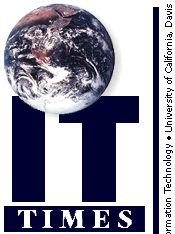
Perspective
Evaluating Internet Sources
by Susan Palo, Campus Writing CenterStudents are increasingly using the Internet for research but they are often uncritical readers. I am currently exploring why students are gullible about the Internet. And I am devising methods to teach them to use Internet sources critically.
Trained researchers realize that because there are few editorial policies and market forces governing the quality of material on the Internet, the reader must beware. Generally, students do not share this caution. Why? Most obviously, because they are students: the aim of their education, still a work in progress, is to teach them to read critically the materials in their field. Such abilities -- whether the ability to assess experimental design in a research article or the persuasive interpretation in a history paper -- are cultivated far into graduate school.
But students are also not wary about Internet sources before they read them. This "why?" is to me a more interesting question. I have noticed that few UC Davis students, except for seniors in their majors, understand the thinking behind these two observations:
- their major professor would not self-publish her current research on the Internet;
- the "facts" or "information" on an advocacy Web page might not be reliable, but the page could be a primary source for research on attitudes or a point of view not available elsewhere.
Which would you trust or use, a current research article in the New England Journal of Medicine or one in Scientific American; a UC Press book or a vanity press book; a ruling by the State Water Board or the Save Mono Lake newsletter? You'll say that your answer depends -- but you know the subliminal calculus for figuring out the relative worth of sources for different research purposes. Most undergraduates do not.
Further, this bibliographic information is relatively hidden for Internet sources -- but it's also great fun to figure it out and demands much sharper detective skills than bibliographic data from print sources. Taking a bibliographic approach to Internet sources becomes a lively introduction to critical reading.
Thus, as a teacher, my critical focus on Internet sources begins with bibliographic data, not content and certainly not graphics or Web page design. I aim to excite critical thinking that will ultimately extend to content. With the students, I usually first "read" a bibliography or reference list from an article, inferring the quality of the sources from the citation data -- usually a revelation to students. Then I give students several problematic Inter-net pages and ask them to reach a preliminary assessment of their probable reliability based on bibilographic data. Students become much more skeptical readers after these exercises.
Resources:
If you are interested in evaluating Internet sources or teaching students to evaluate them, much advice is available on the Internet. But let the reader beware:
- http://www.vuw.ac.nz/~agsmith/evaln/evaln.htm
- (A bibliography on evaluating Internet sources)
- http://www.science.widener.edu/~withers/advoc.htm
- http://www.science.widener.edu/~withers/inform.htm
- (These last two are useful introductions to evaluating an advocacy page and an informational page.)
Susan Palo is a lecturer in the Campus Writing Center.